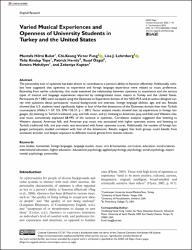| dc.contributor.author | Bulut, Mustafa Hilmi | |
| dc.contributor.author | Fung, Victor | |
| dc.contributor.author | Lehmberg, Lisa | |
| dc.contributor.author | Hernly, Patrick | |
| dc.contributor.author | Kındaptepe, Yeliz | |
| dc.contributor.author | Mehdiyev, Esmire | |
| dc.contributor.author | Özgül, Yusuf | |
| dc.contributor.author | Kaptan, Zekeriya | |
| dc.date.accessioned | 2023-04-10T08:11:14Z | |
| dc.date.available | 2023-04-10T08:11:14Z | |
| dc.date.issued | Oct 2022 | | tr |
| dc.identifier.citation | 2 year impact factor
2.032
Social Sciences, Interdisciplinary 53 out of 111
Total citations made in the JCR year to content published in a journal in the prior two years are divided by the number of articles and reviews published by the journal in the prior two years.
5 year impact factor
2.100
Social Sciences, Interdisciplinary 61 out of 111
Total citations made in the JCR year to content published in a journal in the prior five years are divided by the number of articles and reviews published by the journal in the prior five years.
Immediacy index
0.275
Total citations made in the JCR year to content published in a journal in the same year are divided by the number of articles and reviews published in the JCR year.
Eigenfactor® Score
0.00867
The Eigenfactor Score is weighted such that citations from highly cited publications will have more impact than citations from lesser cited publications. The resulting scores are scaled so that the sum of the Eigenfactor Scores of all journals listed in Clarivate's Journal Citation Reports® is 100.
Article Influence Score
0.490
The Article Influence Score is calculated by dividing the Eigenfactor Score by the number of articles published in the journal over a five year period, and normalizing the scores against the volume of articles published by other JCR journals over a five year period such that the average score is 1.
Cited Half Life
4.9
The Cited Half Life measures the median age of articles in a journal that were cited in the JCR year.
Citing Half Life
9.4
The Citing Half Life measures the median age of the articles that were cited by the journal in the JCR year.
Total Citations
6,347
Total citations to the journal in the JCR year. | tr |
| dc.identifier.uri | https://hdl.handle.net/20.500.12418/13421 | |
| dc.description | Funding
The author(s) disclosed receipt of the following financial support for the research, authorship, and/or publication of this
article: This work was supported in part by Cumhuriyet
University, Sivas, Turkey. | tr |
| dc.description.abstract | Abstract
The personality trait of openness has been shown to contribute to a person’s ability to function effectively. Additionally, scholars have suggested that openness to experience and foreign language experience were related to music preference.
Extending from earlier scholarship, this study examined the relationship between openness to experience and the various
types of musical and language experiences reported by undergraduate music majors in Turkey and the United States.
Participants (N= 380) were surveyed using the Openness to Experience domain of the NEO-PI-R and an author-designed survey with questions about participants’ musical backgrounds and interests, foreign language abilities, age, and sex. Results
showed that U.S. students rated significantly higher in four of the five dimensions of the Openness domain than their Turkish
counterparts (Wilks’l = .57; F(5, 374) = 55.37, p\.001). Factor analysis results showed that (a) experiences in foreign languages, (b) listening to Turkish traditional, pop, and folk music, and (c) listening to American (pop and folk) and Western classical music cumulatively explained 68.49% of the variance in openness. Correlation analyses suggested that listening to
Western classical, American folk, and American pop music was associated with higher openness scores, and listening to
Turkish traditional, folk, and pop music was associated with lower openness scores. Additionally, the number of foreign languages participants studied correlated with four of the dimensions. Results suggest that both groups could benefit from
increased, broader, and deeper exposure to different musical genres from diverse cultures. | tr |
| dc.description.sponsorship | CÜBAP | tr |
| dc.language.iso | eng | tr |
| dc.publisher | SAGE OPEN | tr |
| dc.relation.isversionof | The Author(s) 2022 DOI: 10.1177/21582440221139468 | tr |
| dc.rights | info:eu-repo/semantics/openAccess | tr |
| dc.title | Varied Musical Experiences and Openness of University Students in Turkey and the United States | tr |
| dc.type | other | tr |
| dc.relation.journal | SAGE OPEN | tr |
| dc.contributor.department | Eğitim Fakültesi | tr |
| dc.contributor.authorID | 0000.0002-8231-6214 | tr |
| dc.identifier.volume | https://doi.org/10.1177/21582440221139 | tr |
| dc.identifier.issue | Oct 2022 | 12 (4) | tr |
| dc.identifier.endpage | 10 | tr |
| dc.identifier.startpage | 1 | tr |
| dc.relation.publicationcategory | Uluslararası Editör Denetimli Dergide Makale | tr |















